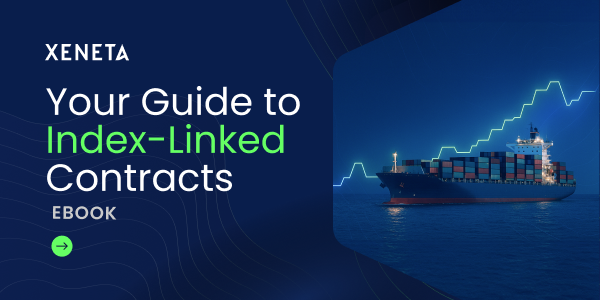Historically, shippers would launch their RFQs around the same time each year, typically inviting their incumbent carrier plus a couple of additional options to tender. They start with a goal – perhaps their CFO has asked them to reduce transportation costs by a target percentage – and they use internal historic data to get as close as possible to achieving that goal.
Sound familiar?
The problem is, that approach no longer works in today’s freight market.
-
Rates are shifting faster than fixed annual cycles can keep up with.
-
Trade disruptions and supply shifts mean that relying on last year’s data can leave you exposed.
-
And limited real-time visibility into carrier performance makes it harder to track whether you’re getting good value or missing better options elsewhere.
To stay competitive, procurement teams need flexible timing, live benchmarks, and granular supplier performance data — not just good relationships with LSPs.
In a recent webinar, Eunice Medina, Director of Customer Success at Xeneta, and Reda Beloui, Director of Enterprise Sales at Xeneta, discussed current best practices for tendering and how a combination of internal and external data will help you achieve the most stable and favorable contracts.
You can watch the full webinar on demand, or read on for the highlights.
The most successful tenders are informed by internal AND external data
Today, the top BCOs are using additional data sets to make the most strategic tender decisions. This data helps them find the best time to launch their RFQ and decide which carriers they want to invite. Combining both internal and external data is the best way to fully understand your position, what’s currently happening in the market, and how suppliers’ performance compares.

To make the right decisions, you need access to:
Internal data
- Historic freight spend and rate trends – to understand your cost baseline
- Transit times and landed cost performance – to assess efficiency, not just price
- Supplier performance metrics – including reliability, communication, and exceptions
- Forecasted volumes and MQCs – to model scenarios and negotiate effectively
External Data
- Real-time market rate benchmarks – to align your RFQs with current conditions
- Rate volatility and seasonal trends by trade lane – to anticipate cost swings
- Macro supply chain signals – including disruptions, capacity shifts, and policy risks
- Peer comparisons and sourcing trends – to understand rate positioning (mid-low to mid-high) before setting RFQ targets
Blending internal KPIs with real-time external benchmarks empowers shippers to make smarter, more agile decisions — optimizing costs, improving supplier performance, and timing RFQs to market conditions, not contract expiry. Today’s procurement strategies hinge on understanding not just “what happened” but what’s likely to happen next. This means looking beyond historical averages to track announced vs, actual transit delays, rate spreads, and predicted disruptions — and how they’ll impact your business milestones.
As one supply chain executive put it:
“We can’t even agree on what an ETA means. The pandemic taught us that we were getting estimated time at birth vs. estimated time at anchor — and those are very different things.”
Transit time data is just one example. Following the Red Sea crisis (October 2023), it wasn’t until June of 2024 that some shippers felt like they could fully trust completed transit data across all lanes. Early signals showed a baseline of +14 days, but true confidence required a broader dataset. For companies managing thousands of ocean lanes, the ability to overlay real-time market data with internal forecasts was, and remains, essential — especially when regional teams interpret data differently.
Standardizing data across regions, modes, and milestones not only transforms static reporting into dynamic, forward-looking planning, it also allows shippers to shift from relying on preferential rates or legacy contracts to using objective, market-aligned benchmarks.
As Medina noted in the webinar:
“Understanding the market position is so important to ensure that you have enough leverage going into negotiations. So, for example, on lanes where you have historically been on market lows, you might want to make sure that you're staying in a market low for those. But maybe for those lanes where you have been historically higher than market average, maybe this time you want to target market average.”
How to internally align around the best approach
Ocean freight buyers are under a considerable amount of pressure and scrutiny from multiple departments.
Your finance team are focused on cost, getting the best rates, and sticking to sometimes arbitrary budgets. Your logistics team might have their own contacts they want to prioritize that will give you better-than-market deals. Your C-suite might have just read an article saying the spot market is softening, but they haven’t noticed that the softening rate is on a completely different shipping route to the one you use.
It’s a lot. But using objective, third-party data helps get everyone back on the same page and aligned around the same goal.
For example, a couple of years ago a Xeneta customer was heavily prioritizing the reduction of CO2 emissions in their strategy. They used the Xeneta platform to create two bid proposals to present to the CFO. One was quite expensive but with very low CO2 emissions, achieved by picking the right carriers with the right transit time at a good price. The other option meant a lower spend but slightly higher CO2 emissions that wouldn’t help them achieve their 2030 emissions goal.
Before signing either contract, the team put both options in front of their C-suite so they could align around the right route forward for the organization. This kind of transparent trade-off helps align stakeholders faster and builds trust between teams.
“You can have the most competitive rate… You can even be below market low. But if you're not working with the right partner... you're putting your business at risk.”
Reda Beloui, Enterprise Account Executive at Xeneta
Get accurate, timely, and real insight with Xeneta
Xeneta is the world’s largest freight rate database, with over 600 million contracted data points for historical analysis and detailed port-to-port trend visibility. But it’s not just about the past — our platform updates in real time, adding 10–15 million new rates every month, and uses machine learning to forecast ocean freight trends 3–6 months in advance.
Procurement and logistics teams use Xeneta to run smarter tenders, evaluate carrier performance, and build data-backed strategies with confidence, not guesswork.



We include data on actual vs. announced transit times, so you can factor timelines into your tendering decisions. Our capacity data shows you which carriers and alliances offer the most capacity and which are using blanked sailings to maintain prices. And we provide carrier spread data so you can look deeper than market averages to see exactly what rates specific carriers are offering to other shippers.
As Beloui shared during the webinar:
“Our goal is to transform the way freight is bought and sold. And to bring transparency between all the players: shippers, freight forwarders, and carriers.”
To explore the topic in more detail, watch the full webinar: What data actually matters in a tender. Flexible. Fair. Future-proof: Rethinking your tender strategy with market intelligence.
And if you want to try the Xeneta platform for yourself, schedule a demo today.
%201.png)






